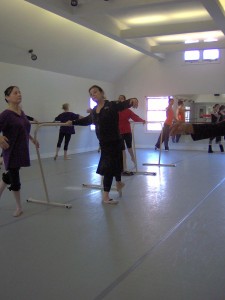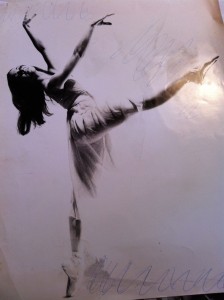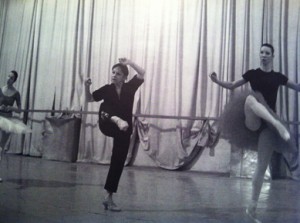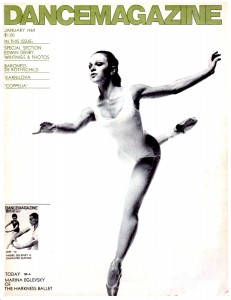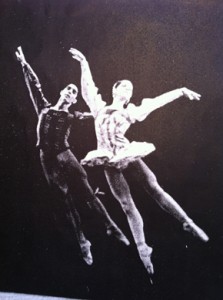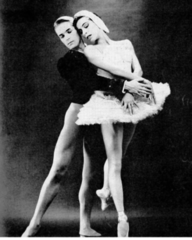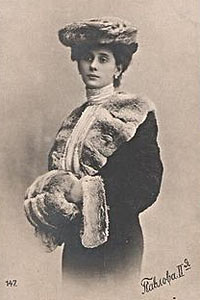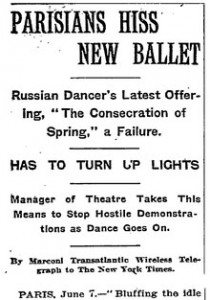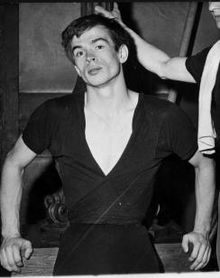This month, we continue with Part 3 of my interview with Marina Eglevsky. We take up where we left off last month, with her move to the Bay Area.
Q: How many years now have you been in the Bay Area?
A: I came here in 1994.
Q: I’m sure my readers at Adults in Ballet would like to know this – I know you’ve talked about this that you felt like your father Andre Eglevsky had really spearheaded the whole idea of lay people, of adults studying ballet – can you talk a little bit about that – he had his school attached to his ballet company, how did he come to invite people into his home to study ballet with him? I’m curious about how all of that happened?
A: Well he didn’t invite anybody – he was so famous that people would come to him – and his school wasn’t that big, one tiny studio that my mother usually taught kids in, and one bigger studio but not very big and he taught his classes in there and there were so many people, it was so crowded – we had children in intermediate and advanced classes. And at the beginning, so many people would come into his advanced class and of any age and he allowed that, but at some point they decided to separate it, so they put the adults in their own class and kept the advanced for the advanced students.
Q: So the adults that came into the advanced class before you separated them, did they have to have a certain amount of technique to get into that class?
A: No, his premise was that – he welcomed most everybody and he felt that if you were a beginner, you stand in the back and you learn. And it’s the very best way to learn, is that you don’t stay in the front, you stay in the back and you watch and you pick up. He thought that was the best way of picking up – and I think they did that in Europe. I’m not exactly sure that he was the very first one in history that had adult classes – maybe not in the U.S., but in Europe, because I know like (Olga) Preobrajenska and Cecchetti, I think they had classes with adults in them and he studied with those teachers. And that’s the way I am, I would see adults come in there that wouldn’t know anything. Especially the guys – not women – the guys – he’d see a guy in the street and say why don’t you come into ballet class?
Q: Really… just because of the way they looked or the way they moved?
A: For instance, he invited a school teacher from down the street into class, and he really improved, he started performing – a lot of them would start performing, my father would have them in productions – we were doing productions all the time. I still feel that way – I teach at Shawl – I welcome adults. I have people at all levels and ages – I am just totally open to that, because of my father.
Q: What I see as a potential problem with adult classes, is the lack of proper correction in class. That’s a big concern I have for ballet training – is having schools that have reputable training – that teachers will take time with each adult, for proper placement.
A: Well in my father’s class you got corrected, he looked at you as learning how to dance and if you could fit in a production, he’d put you in a production. Like this man, who he brought in – he would play the father or the mother in productions – you’re in class your treated as if your wanting to be a dancer. And then he – there were so many adults, the classes were so big – he broke it up, so there were separate adult classes and then he broke those classes into beginning and intermediate dance, so there were 2 levels.
Q: So, what keeps you going now? What keeps you teaching, what keeps you doing the bodywork – is it the natural passion you found as a child?
A: The bodywork is more of a passion – of teaching too I think really a selfish thing – a passion to understand myself better. You know I have to in order to teach – I really have to understand myself and who I am and my – I rekindle my relationship to the essence of – because I’m not a dancer anymore – to the essence of ballet and of movement what ballet is about, what makes something work in a person – and that fascinates me.
Q: Interesting… so, a movement that might work for a particular person, particular technique, with a particular personality, might not work for another person?
A: Well, it’s on many different levels – a level of what would work for this class today – what would make it worthwhile for this class in general – what would work for people in class. Then, there’s what would work for training pre-professionals. I like to gear my focus how to produce that individual so they would become professional material.
Q: For your private ballet coaching and group classes – do you teach weekly?
A: At Shawl Anderson in Berkeley, on Tuesdays and Thursdays I teach an intermediate/advanced adult class. And I also offer private ballet coaching for adults and pre-professionals by appointment.
Q: The bodywork that you do – how would people find out about your bodywork and what are the different methods you use in your sessions with clients?
A: It’s generally word of mouth from my clients – I haven’t sold myself that much.
I do medical massage – and that incorporates acupressure, deep tissue and energetic work, so I do a lot of energy work. And I do alignment work and I look at a person’s alignment and work them through processes and hands on work. I also do rosen method bodywork and also I’ve trained extensively on the gyrotonic machine and I work extensively on that for alignment, but I’m not certified on that. I have a machine in my office and I use some of the movements.
And this concludes my interview with Marina Eglevsky – truly a glimpse into a fascinating life and she carries on the legacy of dance instilled in her by some of greatest legends of the ballet world.
